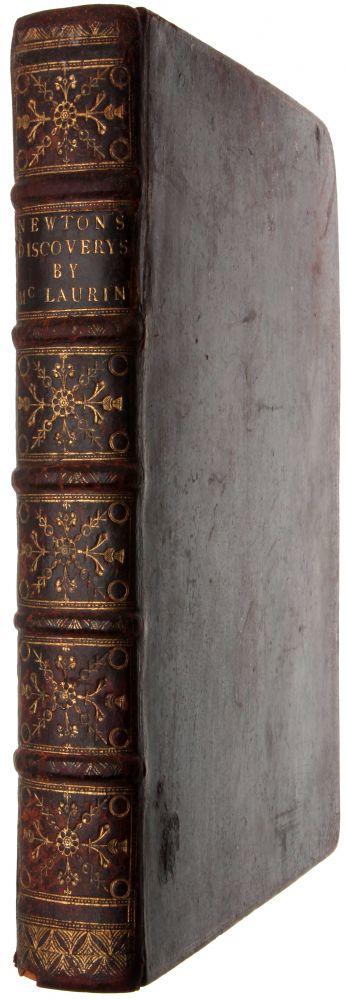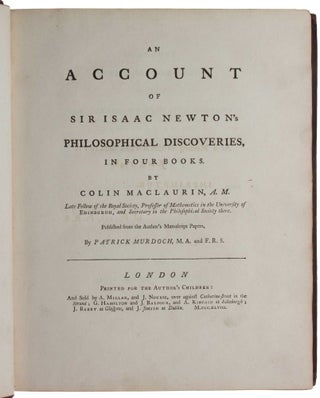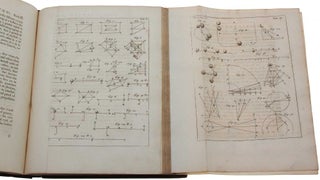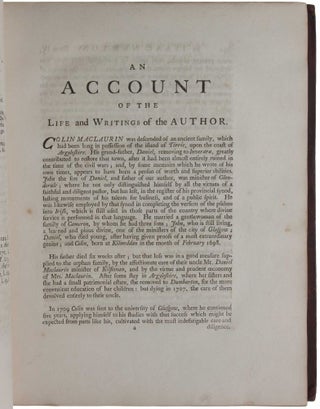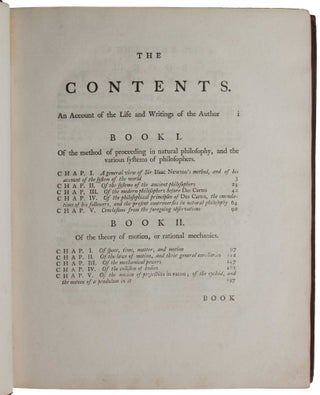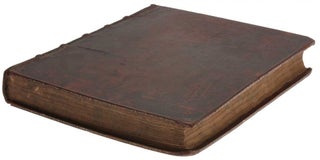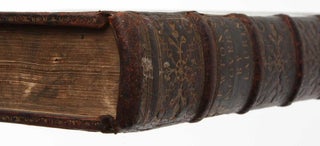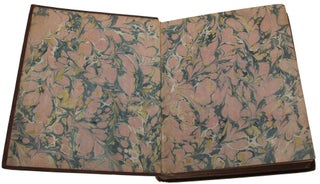An Account of Sir Isaac Newton’s Philosophical Discoveries, in Four Books.
London: Printed for the author’s children and sold by A. Millar, et al. 1748. First edition, large-paper copy, of Maclaurin’s statement of Newtonian theory, one of the three “most outstanding popular introductions to Newtonian science of the eighteenth century” (I. B. Cohen, Franklin and Newton, 1956, p. 209). “Though a number of other general expositions of Newton’s thought were published during the eighteenth century, Maclaurin's Account has long been recognized as the leading authoritative statement of mainstream Newtonianism” (DNB). “Gifted with a genius for geometrical investigation second only to Newton’s… Maclaurin, the one mathematician of the first rank trained in Great Britain in the [18th] century, confirmed Newton’s exclusive influence over British mathematics” (ibid.). Maclaurin’s most his most important work, Treatise of Fluxions (1742), was “the earliest logical and systematic publication of the Newtonian methods. It stood as a model of rigor until the appearance of Cauchy’s Cours d’Analyse in 1821” (DSB). This superb large-paper copy of Maclaurin’s Account, measuring 289 x 231mm, is larger than those in both the Macclesfield library (285 x 222mm) and the Richard Green library (288 x 227mm) – those copies realized £6,600 and $6,250 in 2005 and 2008, respectively. After Newton’s death in March 1727, his nephew-in-law John Conduitt started to collect materials for a biographical memoir of Newton and applied to several of Newton’s contemporaries, including Maclaurin, for assistance. Although Conduitt’s memoir never materialized (although some of the materials he collected made their way into Fontenelle’s Éloge in 1728), his request prompted Maclaurin to prepare an account not only of Newton’s discoveries in astronomy, gravitation and mechanics (though omitting his work on optics), but also of the philosophical systems that preceded Newton’s. Maclaurin had nearly completed this work when, during the Jacobite rebellion of 1745, a Highland army marched upon Edinburgh. Maclaurin took a prominent part in preparing trenches and barricades for the city’s defense. As soon as the rebel army captured Edinburgh, Maclaurin fled to England until it was safe to return. But the ordeal of his escape ruined his health, and he died at age 48. “Only a few hours before his death he dictated the concluding passage of his work on Newton’s philosophy, in which he affirmed his unwavering belief in a future life” (DSB VIII: 612). Maclaurin’s pupil at Edinburgh, Patrick Murdoch (d. 1774), published the book by subscription for the benefit of Maclaurin’s children, prefaced by a memoir of the author that is the chief authority for the life and writings of Maclaurin. Maclaurin gives a hagiographical and nationalistic account of the philosophical importance of Newton, presenting him as a great synthesizer of ideas. He drew attention to the issue of methodology: to the classic procedures of induction, deduction and verification, noting that the scientist “should begin with phenomena, or effects, and from them investigate the powers or causes that operate in nature; that from particular causes we should proceed to the more general ones, till the argument ends in the most general: this is the method of analysis. Being once possessed of these causes, we should then descend in a contrary order, and from them, as established principles, explain all the phenomena that are their consequences, and prove our explications; and this is the synthesis. It is evident that, as in mathematics, so in natural philosophy, the investigation of difficult things by the method of analysis, ought ever to precede the method of composition, or the synthesis. For in any other way we can never be sure that we assume the principles that really obtain in nature; and that our system, after we have composed it with great labour, is not mere dream and illusion.” The empirical work of others such as the continental astronomers Tycho Brahe and Johannes Kepler is noted but subordinated, the ‘philosophical improvement’ of their work ‘reserved’ for Newton. Also notable is a lengthy discussion of Newton’s theology, showing the persistent relevance of this facet of Newtonianism to the gentlemanly natural philosopher of the 18th century. A child prodigy, Colin Maclaurin (1698-1746) entered the University of Glasgow aged 11. At the age of 19 he was elected a professor of mathematics at Marischal College, Aberdeen, and two years later he became a fellow of the Royal Society of London, and there became acquainted with Newton. On the recommendation of Newton, he was made a professor of mathematics at the University of Edinburgh in 1725. In 1740 he shared, with Leonhard Euler and Daniel Bernoulli, the prize offered by the French Academy of Sciences for an essay on tides. His most important work, Treatise of Fluxions (1742), was written in reply to criticisms by Bishop George Berkeley that Newton’s calculus was based on faulty reasoning. The subscriber’s list names 1,227 subscribers who ordered 1,436 copies. Babson 85; Gray 112; Macclesfield 1285.
4to (289 x 231mm), pp. [xxviii], xx, 392, and six folding engraved plates with 71 figures. Contemporary mottled calf, spine gilt (minor restoration to ends of joints and capitals, some light scuffing).
Item #3409
Price: $3,500.00

